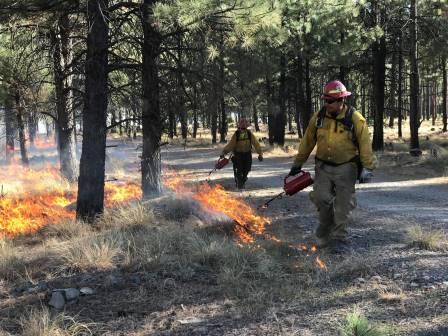You are viewing ARCHIVED content published online before January 20, 2025. Please note that this content is NOT UPDATED, and links may not work. Additionally, any previously issued diversity, equity, inclusion or gender-related guidance on this webpage should be considered rescinded.
Author: Fort Apache Agency
Fort Apache Agency has a long legacy of prescribed burning treatments dating back to the 1950’s. From 1950 to 1970, more than 300,000 acres were treated on the Fort Apache Indian Reservation, primarily for hazardous fuel reduction. During the 1980s, 347,778 acres were treated and during the 1990s, 197,257 acres were treated with prescribed fire.
Fort Apache Agency and the White Mountain Apache Tribe have effectively treated the Apache Homelands and has been a primary leader in prescribed fire in Indian Country. Prescribed fire treatments began on October 17, and ended on December 4, 2017. In total 37,859 acres within 11 burn blocks were treated on the Reservation. To achieve this, Fort Apache Agency and White Mountain Apache Tribal Forestry firefighters worked long hours and walked an average of 10 to 20 miles a day to complete the project.
Every year, devastating wildfires threaten the Reservation, but by conducting small prescribed burns, fire managers can minimize the unintended consequence of wildfires. Treatments such as these were successful in slowing down and reducing the fire effects of such fires as the Rodeo-Chediski Fire, Wallow Fire and most recently the Cedar Fire that burned on the San Carlos Apache Reservation in 2017.
Before prescribed fires take place, prescribed burn plans are written by each burn blocks for their respective burn units, submitted to Tribal Project and Review for approval, and submitted to the Agency Superintendent for final approval. A major component of the plan takes into account smoke management. Smoke is made up of a complex mixture of gases and fine particles produced when wood and other organic materials burn. Burn plans provide guidance for burn bosses to follow so smoke is minimized and does not create unhealthy conditions. Burn bosses mitigate smoke impacts by ensuring they burn during optimal weather conditions.
Fire plays an important role in the overall health of the forest and within the Apache culture. Considered a sacred element to the Apache, it is to be respected. Every living being within a forest habitat depends on the effects fire has on the landscape. It restores the health and vigor of native vegetation, reduces weeds and exotics, enhances wildlife habitat, removes biomass in a cost-effective way, increases plant diversity, releases nutrients vital to new plant growth and reduces the risk future wildfires may have. Prescribed fire is one of the most cost effective and natural ways to protect and restore our landscape.
Special thanks go out to surrounding communities for understanding the need to continue prescribed burning efforts on our Apache homeland. Prescribed fire has proven to be successful in restoring the land and reducing the risk of wildfires.
Prior to completing these projects, firefighters had a long fire season. They work in adverse weather conditions for long gruesome hours and are expected to be away from their families for long periods of time. We wish to thank these hard working men and women for their hard work and dedication throughout the year. Fort Apache Agency certainly appreciates the work they do for the land and the Agency and the White Mountain Apache Tribe.
For Immediate Release: December 1, 2017


